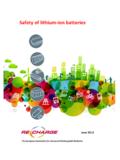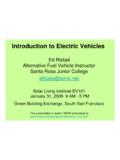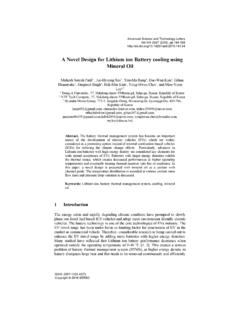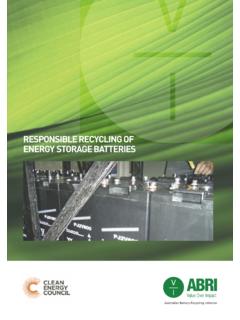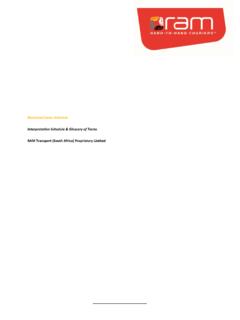Transcription of GAIA Li-Ion Batteries: Evolution or Revolution?
1 November 2005 November 2005 GAIA Li-Ion batteries : Evolution GAIA Li-Ion batteries : Evolution or Revolution? or Revolution? GAIA EuropeGAIA EuropeCompany SecretaryCompany SecretaryTim Tim Sch ferSch ferAkkumulatorenwerke GmbH, Akkumulatorenwerke GmbH, NordhausenNordhausen, Germany, GermanyLithium Technology Corporation, Plymouth Meeting, PA, USAL ithium Technology Corporation, Plymouth Meeting, PA, USAP roprietary Information, November,2005 Overview Company Overview Technology Manufacturing Process Product Portfolio Target Markets Hybrid Electrical Vehicle Battery Cell Level- Discharge Performance- Cycle Life- Calendar Life and Self Discharge- Safety Aspects Battery Management System Battery Level- Design of 288V Battery and Prototype- Pulse Power Performance Applications Developments SummaryCompany Company OverviewOverviewProprietary Information, November.
2 2005 History April 1996 Founding of GAIA 1997 Proprietary extrusion process 1998 Arch Hill, a Dutch venture capital company, acquires majority share of GAIA 1999 Installation of three pilot extrusion lines 2000 Refinement of battery production facilities 2002 Merger of GAIA and LTC 2003 Market entry with large format Lithiumion cells 2005 Market entry with lithium ion batteriesProprietary Information, November,2005 lithium Technology Corporation is a Public US Corporationtraded on the OTC Bulletin Board ( ) LTC and GAIA were merged in 2002 combining twosynergistic technologies(US Operations)Plymouth MeetingPennsylvania (USA)GAIA Akkumulatorenwerke, GmbHNordhausenThuringia (Germany) lithium Technology CorporationPlymouth MeetingPennsylvania (USA)Corporate StructureProprietary Information, November,2005 FacilitiesUS Operations(LTC - Plymouth Meeting)
3 Corporate Headquarters US Government/MilitaryDevelopment Contracts R & D and cooperativeprograms with US rawmaterial suppliers US Sales Battery design and assemblyusing GAIA cells Limited contract productionof specialty flat cellsEuropean Operations(GAIA - Nordhausen) European DevelopmentContracts R & D and cooperativeprograms with EU rawmaterial suppliers European Sales Commercial Production ofcylindrical cells Battery design andassemblyProprietary Information, November,2005 Small Production/Large Pilot Scale Operation 57 Employees (17 in US, 40 in Germany) FACILITIES 176,000 ft2 facility in Nordhausen, Germany 13,000 ft2 facility in Plymouth Meeting, PA, USA PRODUCTS.
4 Custom engineered batteries Development contracts Cylindrical and prismatic lithium -Ion cells - from 5 Ah to 120 AhCurrent OperationsGAIA TechnologyGAIA TechnologyProprietary Information, November,2005e-e-e-Copperneg. Collector(Anode)Li+ conductiveElectrolyteLi+Li+Li+Li+Li+e-e- e-Aluminiumpos. Collector(Cathode)LixC6Li1-xMO2A +Discharge Current ICharge Current IPrinciple of lithium Ion BatteriesProprietary Information, November,2005 Technological Advantages of lithium -Ion over otherChemistriesLow( per cell)High( per cell)Medium(2V per cell)Battery Complexity(Number of Cells)
5 Very WideWideNarrowOperationalTemperature RangeVery LowLowHighHeat GenerationVery GoodGoodPoorFast Charge3 to 10 x3 to 6 x1 Power per Volume5 to 15 x5 to 10 x1 Power per Weight2 x1 Energy per Volume3 x2 x1 Energy per WeightLi_IonNiMHLead AcidProprietary Information, November,2005 Proprietary cell design IP Low internal resistance allows for high power output andrapid charging with limited heat generation Proprietary manufacturing process Lower cost extrusion and assembly allows scalability andopportunity for high gross margins Environmentally friendly (no solvents) Patents Issued33 Applications Pending 42 LTC DifferentiatorsProprietary Information, November,2005Li-Ion TechnologyIIIIIIIVVI: Al-Collector (18-25 m)II: Positive Electrode (40-200 m)III: Separator (16 35 m)IV.
6 Negative Electrode (30-150 m)V: Cu-Collector (12-20 m)Manufacturing ProcessManufacturing ProcessProprietary Information, November,2005 Process - Extrusionelectrolytedry blendcathodeelectrolytedry blendanodegraphit, polymersand carbon blackLiCoO2,polymers andcarbon blackmixing and drying ofcathode materialsmixing and drying ofanode materialspolymer anodeon carrier foilpolymer cathodeon carrier foilyggyy No emission of solvents Safe and environmental No ex-proof installation Cost-effective Co-extrusion of polymer blendsProprietary Information, November.
7 2005 Process - Laminationanodematerial oncarrier foil1lamination ofanodelaminate of anode / Cu / anodeProprietary Information, November,2005 Processing Technology - Winding & Assemblingcathode currentcollector "Al"anode currentcollector "Cu"tab and lidassemblyhousing laser weldinglid withterminalsanode polymer electrolytecathodepolymer electrolytecell winding machineGAIA Product PortfolioGAIA Product PortfolioProprietary Information, November,2005 GAIA Product Portfolio Present cylindrical cellsrange in capacity from 5 Ah to60 Ah GAIA offers two basic typesof products taylored todifferent applications The HE product series is optimized towards high energy contentwith moderate rate capability (continuous discharge up to 2C) The HP and UHP series are designed to deliver maximum power(continuous discharge up to 10C)
8 GAIA has developed battery packs of up to 600V to customerspecificationsProprietary Information, November,2005 Battery Systems Comparison - Ragone PlotProprietary Information, November,2005 GAIA cells offer the highest power of any commerciallithium ion cell in the western hemisphere* (most amperesor watts per kilogram) GAIA UHP product achieves 2400 W/kg (pulse) GAIA cells are the largest lithium ion cells produced in thewestern hemisphere (most energy capacity - watt-hours oramp hours) GAIA HE-602050 has 60 Ah or 216 Wh corresponding to 150Wh/kg 120 Ah cell is in development LTC specializes in working with the customer to engineersolutions using standardized cells in customizedconfigurations Custom engineered battery packs including electronic batterymanagement systems* US and EU companies have an advantage selling the western hemisphere beingdomestic suppliers and it is unrealistic for US and EU companies to sell into.
9 High Power Engineered lithium Ion Is LTC s CoreExpertiseGAIA GAIA MarketsMarketsProprietary Information, November,2005 TransportationApplications require rapidcharging rates and longlife in safe, durable highpower storage for HEV, EVand fuel cell poweredvehicles. Military, heavyduty and niche vehicleOEMs are early niches PowerGrowing dependence onelectrical power worldwidedrives the demand for highquality high-reliability powerfor telecommunications,computers, mission criticalapplications, remote mobileand renewable powerapplications.
10 Very largepotential with Projected Growth in Advanced BatteriesMilitary/NationalSecurityApplic ations requireflexibility in design, wideranges of power output,broad operatingtemperatures, low weightand thousands of rechargecycles. Performance is moreimportant than need is growingquickly. Developmentfunding is Information, November,2005 The US and its allies are changing the militarylandscape. The trend is to many small, rapidly deployedunits using extensive power-intensive already exist in this market and continueto grow rapidly.
